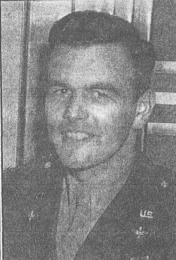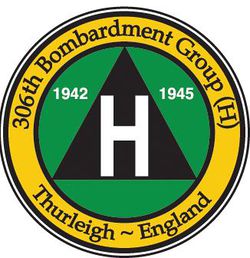Encyclopedia Dubuque
"Encyclopedia Dubuque is the online authority for all things Dubuque, written by the people who know the city best.”
Marshall Cohen—researcher and producer, CNN
Affiliated with the Local History Network of the State Historical Society of Iowa, and the Iowa Museum Association.
SAUNDERS, Frank
SAUNDERS, Frank. (Dubuque, IA, Feb. 24, 1920- ). Known locally as "Frankie," Saunders was also a well-known CYO amateur boxer. The Columbia Academy rifle team, of which he was a member, was so successful it once competed for the Hearst Cup in the Camp Perry National Rifle Competition held in Booneville, Missouri.
A bomber pilot during WORLD WAR II, Saunders rose to the rank of first lieutenant and with the 306th Bomber Grout stateside from April 1942 until July 1942. He was transferred to the 303rd on July 6. 1942 and shot down on January 3, 1943 on his fifth mission a in B-17F 41-24608 Flying Fortress nicknamed 'Yahoodi' while serving as pilot. The plane had been part of an attack on the German submarine base at St. Nazaire, France. (1) Saunders was credited with the destruction of six Axis planes before his plane was forced down. (2) Crashing into Bay of Biscay, he and his co-pilot survived but the co-pilot drowned before rescued by a French fishing boat.
Saunders was a POW at Oflag 64 or 21B Shubin, Poland and then to Stalag Luft III near Berlin. While a prisoner in the German camp, Saunders and Frank Sneed, also of Dubuque, slipped under the barbed wire and attempted to reach a nearby camp with Russian soldiers to trade watches for food. En route, they were caught in an American strafing attack, but escaped uninjured. The two Americans completed their mission and returned to their camp with food to supplement their P.O.W. rations of cabbage and black bread. (3)
Prisoners at Stalag Luft III began planning ways of escaping as soon as they were made prisoners. Their great escape was immortalized in the blockbuster motion picture "The Great Escape" starring James Gardner, Steve McQueen and many others. Requiring months of planning, the escape involved three tunnels with code names Tom, Dick and Harry. The main escape was to be made through Tom with the other two tunnels and others developed as decoys. Because he could use a typewriter, Saunders was assigned as a prisoner aide in the German general's office. By interviewing new prisoners, Saunders was able to discover what they did in civilian life and assign them to duties to aid the escape plan. (4)
Unlike the movie, just two days before the escape was planned all Americans in the camp were moved out. Saunders believed the Germans must have known of something being planned. The Americans were forced to march 97 miles through the snow to a train station from which they were transported to a camp near Mooseburg, Germany. It was from there that they were finally released. The escape was carried out, but of the eighty-eight men who escaped fifty were captured in the woods near the camp. They were shot and cremated with their ashes brought back to the camp as a warning for others. Saunders was assigned to escape with a Canadian who was later captured. As he later said, "I guess it was a good thing we were moved." (5)
For his service, Frank Saunders, received the Prisoner of War Medal and Purple Heart. (6)
Living in Chicago after the war, he accompanied a friend to a modeling agent and was soon making eighty dollars a day. Despite the income, he returned to Dubuque to complete his college work at LORAS COLLEGE. (7)
Saunders returned to Chicago, worked as a janitor at the Merchandise Mart at night and looked for modeling work during the day. He became one of the nation's most recognized models through his major account, Kreml Hair Cream. Recognized by millions but unknown by name, he was also the man, according to the advertisements, who owned Pontiacs, wore Alligator Rainwear, used Revere cameras and preferred Griesedieck beer. He appeared in Life magazine and the pages of Saturday Evening Post He even earned a role in the 1949 motion picture "The Great Gatsby" starring Alan Ladd. (8)
In 1951 Saunders began making product commercials, ads accompanying theater movies, and industrial films. (9)
In 1956 with a family, beginning to feel he was too old for what he was doing, and reeling from the death of a friend in an automobile accident, Saunders return to Dubuque to work for the DUBUQUE RETAIL MERCHANTS BUREAU, serve as the secretary of the chamber of commerce, and sell real estate. He later went to work for the postal service. (10)
---
Source:
1. Reber, Craig D. "WWII Vet Celebrates 60th Anniversary of Liberation," Telegraph Herald, May 30, 2005, p. 1A
2. "Lt. Saunders Writes Home," Telegraph-Herald, March 16 1943, p. 14
3. Hooten, Leon, ""Dubuquer a Prisoner With Sneed, a Middle-Aged Lion," Telegraph-Herald, December 11, 1966, p. 21
4. Babcock, Sue, "Weekend of Reliving 'The Great Escape,'" Telegraph Herald, April 26, 1970, p. 16
5. Ibid.
6. "Frank A. Saunders," American Air Museum in Britain. Online: http://www.americanairmuseum.com/person/66902
7. McCormick, John. "Frank Saunders: Recalling the 'Slick' Old Times," Telegraph Herald, June 15, 1981, p. 5
8. Ibid.
9. Ibid.
10. Ibid.






